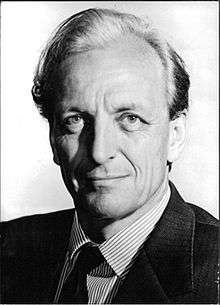Jack Cater
| Jack Cater KBE, JP | |
|---|---|
 | |
| Chief Secretary of Hong Kong | |
|
In office 1978 – November 1981 | |
| Governor | Murray MacLehose |
| Preceded by | Denys Roberts |
| Succeeded by | Philip Haddon-Cave |
| 1st Commissioner of the Independent Commission Against Corruption | |
|
In office 15 February 1974 – 3 July 1978 | |
| Governor | Murray MacLehose |
| Succeeded by | Donald Luddington |
| Personal details | |
| Born |
21 February 1922 London, United Kingdom |
| Died |
14 April 2006 (aged 84) Guernsey |
| Nationality | British |
| Spouse(s) | Peggy |
| Children | 3 |
Sir Jack Cater, KBE, JP (Chinese: 姬達爵士; 21 February 1922 – 14 April 2006) was the Chief Secretary of Hong Kong from 1978 to 1981. Cater was the third Chief Secretary under the Governorship of Sir Murray MacLehose, later Lord MacLehose of Beoch. He is probably most noted for his role as the founding Commissioner of the Independent Commission Against Corruption of Hong Kong.
Biography
Career
Cater began his career in Hong Kong in 1946 as a cadet officer in the Fisheries Department, and was made Director of Agriculture and Fisheries in 1964. He was appointed by then Governor David Trench to lead the team that restored peace and security following the riots in 1967. He served two years as Executive Director of the Hong Kong Trade Development Council, and went on to become Defence Secretary and Director of Government Information Services.
Cater was instrumental in establishing schools in all of Hong Kong's fishing villages.
In February 1974, he was delighted to accept appointment to the first Commissionership of the Independent Commission Against Corruption (ICAC) by Murray MacLehose following the flight of Police Superintendent Peter Godber. His widow later revealed that Cater considered at one point leaving the government. She said:
| “ | People did not want to believe there was such rampant corruption in Hong Kong. He had tried very hard to persuade people that we had to do something about it, but nobody was prepared to listen.[1] | ” |
Cater was widely respected and much liked in Hong Kong for the way in which he brought the fledgling ICAC to the point where it became strong enough to survive the attacks of vested interests, and of its many enemies both within and without the government. As a result of Cater's vital early direction, the ICAC was able to grow into a body which presided over the (almost total) eradication of corruption, both official (Governmental) and elsewhere, in Hong Kong.
In 1995, he was awarded an Honorary Degree (Doctor of Laws) by the University of Bath.[2]
Personal
Married to Peggy in 1950. The couple lived most of their life together in Hong Kong, until the late 1990s. They had three children: Susan, Jacqueline and Richard.
Sir Jack and Lady Cater returned to Britain, and settled on Guernsey in the Channel Islands in 2001. Cater suffered from Alzheimer's disease during the final few years of his life. He died in Guernsey on 14 April 2006, aged 84.
A memorial was held for him in Hong Kong at the St. John's Cathedral on 21 October 2006, attended by many senior officials and prominent figures, inter alia Hong Kong Chief Executive Donald Tsang, Run Run Shaw, David Akers-Jones, former Secretary for Security Alistair Asprey, as well as Raymond Wong and Lily Yam, respectively the then current Commissioner and a former Commissioner of the ICAC.
See also
References
- ↑ Lee, Klaudia (22 Oct 2006), "Cater was ready to quit over graft, says widow.", South China Morning Post
- ↑ "Honorary Graduates 1989 to present". bath.ac.uk. University of Bath. Retrieved 18 February 2012.
- South China Morning Post, 22 October 2006 "In memory of HK's 'knight in shining armour' " (Page 3)
| Government offices | ||
|---|---|---|
| Preceded by Sir Donald Luddington |
Secretary for Home Affairs 1973 |
Succeeded by Dennis Bray |
| Preceded by Sir Denys Roberts |
Chief Secretary of Hong Kong 1978 – 1981 |
Succeeded by Sir Charles Philip Haddon-Cave |
| Preceded by Terence Dare Sorby |
Director of Commerce & Industry and Commissioner of Preventive Service 1970 – 1972 |
Succeeded by David Harold Jordan |
| New division | Commissioner, Independent Commission Against Corruption 1974 – 1978 |
Succeeded by Sir Donald Luddington |